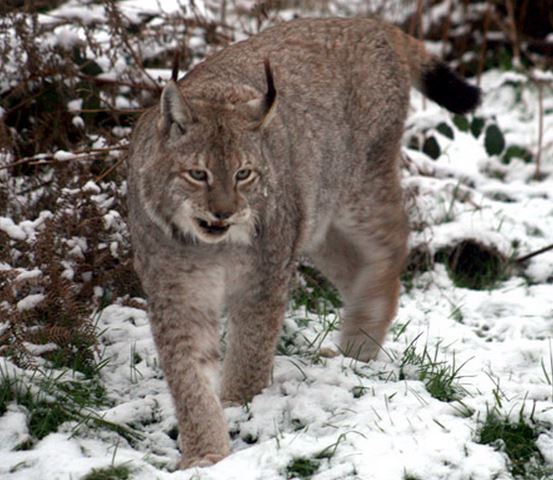The Eurasian Lynx, Europe’s third largest predator after the brown bear and the grey wolf, could be roaming the woodlands of Britain again after 1,300 years, says Lynx UK Trust, if its scheme is approved.
The Lynx UK Trust would like to release Eurasian lynx onto three privately owned, in-fenced estates in Aberdeenshire, Cumbria and Norfolk.
Dr Paul O’Donoghue, the Trust’s Chief Scientific Advisor, who manages several international projects, including working with some of the world’s most endangered species such as black rhinos and pygmy hippos, said:
“The lynx is one of the most enigmatic, beautiful cats on the planet. The British countryside is dying and lynx will bring it back to life.”

Lynx Trust UK says that the British lynx was most closely related to Northern European lynx, which are typically grey with a white, lightly spotted belly. (Image: Lynx Trust UK)
The Eurasian lynx, a medium-sized cat native to European and Siberian forests, Central and East Asia, has powerful long legs, with large webbed and furred paws. Due to its solitary nature, the animal does not present a threat to humans.
National Survey
The Lynx UK Trust has launched a national survey to gather the opinions of people across the country on lynx reintroduction. It will then submit a formal application with Scottish Natural Heritage and Natural England, the two agencies that would license the release of the wild animals.
If the plan goes ahead, the Trust will release between four and six Eurasian lynx later this year at each of the three sites, which have plenty of woodland and are rich in deer. They will all be wearing GPS tracking collars.
The UK has a population of over one million wild deer – an animal that has no natural predator in Britain. The Trust says the lynx would help control deer numbers.
Peter Watson of the Deer Initiative welcomes the Trust’s plan to reintroduce lynx in Britain, saying it would help control deer populations in a sustainable way.
Many farmers are not so keen on the idea. They say they would attack gamebirds and livestock. In Romania and Poland, where lynx live naturally, attacks on livestock are extremely rare.

The Eurasian lynx hunts a wide range of prey but tends to focus on roe deer whenever they are available. (Image: Lynx Trust UK)
Lynx UK Trust says there is a legal framework that structures potential reintroductions to ensure successful outcomes. The framework focuses on both the interests of target species and the general public. To address this second point it has started the process of collecting public opinion.
The Trust is asking people to help it get a clear picture of public opinion regarding the reintroduction of these cats as part of a controlled and monitored scientific trial. “Tell us what you think here,” it adds.
Scotland wants to reintroduce Eurasian Lynx
In December 2014, the Scottish Wildlife Trust said it wanted to reintroduce the once native Eurasian Lynx to Scotland for “both moral and ecological” reasons.
In Scotland, the lynx became extinct due to habitat loss and persecution.
The Scottish Wildlife Trust says that bringing back the lynx would help restore the balance in the country’s natural ecosystems, which continue suffering from pervasive threats, including overgrazing and inappropriate development.
The Trust’s CEO Jonny Hughes, said:
“The Scottish Wildlife Trust has experience in bringing keystone species back to Scotland, having been a lead partner in the groundbreaking Scottish Beaver Trial, a trial reintroduction of the Eurasian beaver to Argyll. This was the first ever licensed reintroduction of a mammal species to the UK.”
“The five-year scientific monitoring period of the Scottish Beaver Trial has now come to an end and we await a ministerial decision on the future of beavers in Scotland. We believe that lynx should also be considered for reintroduction and in many ways could be a flagship for the restoration of native habitats, particularly woodlands into the future.”
“Although reintroductions of this nature are complex and must follow strict international guidelines, Scotland is leading the way with its new Scottish Code for Conservation Translocations launched by the Scottish Government earlier this year, through the work of the Scottish National Species Reintroduction Forum of which the Trust is a key member.”
The Eurasian lynx
The Eurasian Lynx (Lynx lynx), also known as the European lynx, Siberian/Russian lynx, common lynx, and northern lynx, is a medium-sized cat native to Siberian, European, East Asian and Central Asian forests.
Eurasian lynx populations have been reduced or extirpated in western Europe, where it is being gradually reintroduced in several areas.
It is the largest of all the lynx species, with a length from 80 to 130 cm (31 to 51 inches) and a height of 60 to 75 cm (24 to 30 inches) at the shoulder.
Males weigh from 18 to 30 kg (40 66 lbs), while females weigh from 8 to 21 kg (18 to 46 lbs).
They prey on small to quite large mammals and birds, such as roe and red deer, reindeer, moose, wild boar, red foxes, rodents, squirrels, hares, and rabbits.
